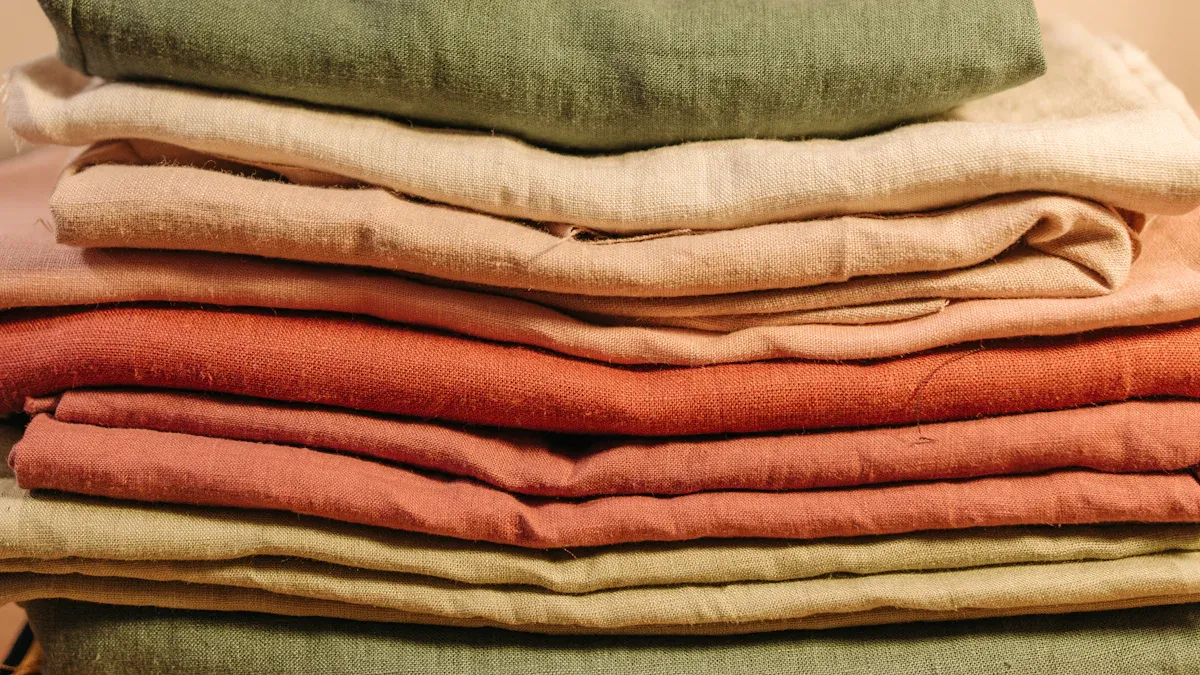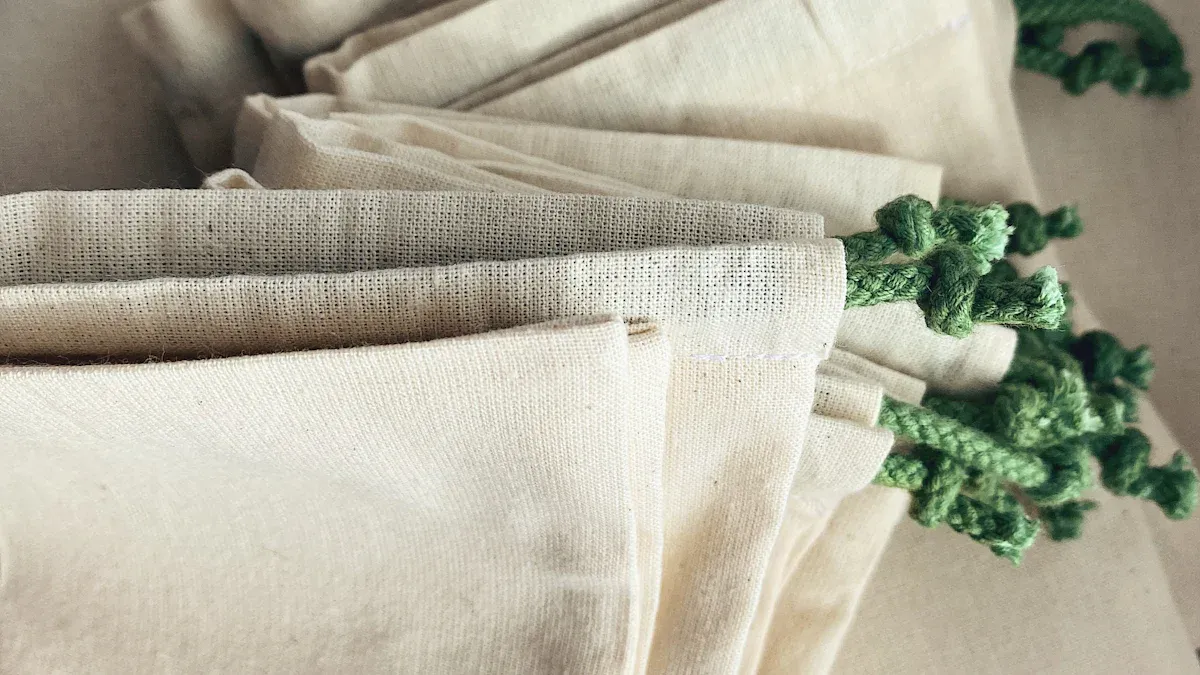
Sustainable fabrics bring numerous advantages to the environment, economy, and society. By choosing these materials, you help reduce waste and conserve valuable resources like water and energy. For example, traditional cotton farming consumes nearly 10,000 liters of water to produce just one kilogram of cotton.
Sustainable alternatives, such as organic cotton or recycled fibers, significantly lower this impact. These eco-friendly materials are gaining popularity as people seek more sustainable choices in their wardrobes.
Additionally, the global eco fiber industry, valued at USD 40.38 billion in 2020, continues to grow as more people embrace eco-friendly choices. These fabrics also promote ethical practices, ensuring fair treatment of workers and reducing reliance on petroleum-based textiles, which heavily pollute the planet.
Key Takeaways
- Picking sustainable fabrics cuts waste and saves water and energy.
- These fabrics support fair jobs and safe workplaces for workers.
- Using eco-friendly materials reduces pollution and helps the planet.
- Strong sustainable fabrics save money by lasting longer and needing fewer replacements.
- Check for labels like GOTS and OEKO-TEX to make sure fabrics are safe and eco-friendly.
What are Sustainable Fabrics and Why Do They Matter?

What are sustainable fabrics?
Sustainable fabrics are materials designed to minimize harm to the environment while promoting ethical and economic sustainability. These fabrics reduce resource consumption, avoid harmful chemicals, and support fair labor practices. For example, organic cotton uses 93% less water than conventional cotton and avoids synthetic chemicals. Similarly, recycled polyester transforms discarded materials into high-quality fibers, reducing the need for virgin resources. By choosing sustainable fabrics, you contribute to preserving the planet and supporting ethical practices.
Sustainable fabrics also meet specific certifications that ensure their eco-friendly and ethical nature. For instance:
- Global Organic Textile Standard (GOTS) guarantees organic fibers and compliance with environmental and social standards.
- OEKO-TEX® Standard 100 ensures textiles are free from harmful substances.
- Global Recycle Standard (GRS) validates products containing recycled content.
Types of sustainable fabrics
Organic fabrics (e.g., organic cotton, hemp)
Organic fabrics come from crops grown without synthetic chemicals or genetically modified organisms (GMOs). Organic cotton and hemp are popular examples. Hemp requires minimal water and grows quickly, making it highly sustainable. However, only organic hemp avoids chemical processing. Look for certifications like GOTS to ensure authenticity.
Recycled fabrics (e.g., recycled polyester, upcycled materials)
Recycled fabrics give new life to waste materials. Recycled polyester, for example, uses discarded plastics like bottles to create durable fibers. Upcycled materials repurpose old textiles into new products, reducing landfill waste. These options lower reliance on virgin resources and help combat plastic pollution.
Innovative fabrics (e.g., Tencel, Piñatex, mushroom leather)
Innovative fabrics use cutting-edge technology to create sustainable alternatives. Tencel, made from wood pulp, is biodegradable and requires less water. Piñatex, derived from pineapple leaves, offers a plant-based leather alternative. Mushroom leather, another vegan option, grows from fungi and avoids animal cruelty.
Natural fibers (e.g., wool, linen, bamboo)
Natural fibers come from renewable sources and are biodegradable. Wool is moisture-wicking and renewable but requires ethical sourcing. Linen, made from flax, grows quickly and produces minimal waste. Bamboo grows rapidly and needs fewer resources, though some processing methods may involve chemicals.
How Do Sustainable Fabrics Benefit the Environment?

Lower carbon footprint
Sustainable fabrics help you reduce your carbon footprint by using materials and processes that emit fewer greenhouse gases. For example, natural and recyclable materials like organic cotton or recycled polyester require less energy during production. This means fewer emissions compared to conventional fabrics. Globally, 1.3 billion tons of waste end up in landfills every year. By choosing sustainable fabrics, you help reduce this waste and the harmful gases it produces.
Life cycle assessments (LCAs) also play a key role in lowering carbon footprints. These assessments compare the environmental impact of different materials and guide designers toward eco-friendly options. When brands use LCAs, they can create products with a smaller environmental impact, helping you make greener choices.
Conservation of water and energy
Sustainable fabrics conserve water and energy, which are vital resources for the planet. Organic cotton, for instance, uses 88% less water and 62% less energy than conventional cotton. This is because organic farming avoids water-intensive irrigation and relies on natural rainfall. In some cases, organic cotton farming reduces water usage by as much as 93%.
By choosing fabrics made from recycled materials, you also save energy. Recycling uses less energy than producing new materials from scratch. For example, recycled polyester requires fewer resources than virgin polyester, making it a smarter choice for the environment.
Reduction of pollution and waste
Sustainable fabrics minimize pollution and waste by using cleaner production methods and repurposing materials. Organic farming avoids harmful pesticides and fertilizers, which often pollute soil and water. Recycled fabrics, like those made from plastic bottles, keep waste out of landfills and oceans. This reduces the amount of trash harming wildlife and ecosystems.
Innovative fabrics, such as Piñatex and mushroom leather, also contribute to waste reduction. These materials use byproducts from other industries, turning waste into valuable resources. By supporting these innovations, you help create a cleaner, healthier planet.
Protection of ecosystems and biodiversity
Sustainable fabrics play a vital role in protecting ecosystems and preserving biodiversity. Conventional textile production often harms the environment by polluting water, degrading soil, and destroying habitats. By choosing sustainable fabrics, you help reduce these negative impacts and support a healthier planet.
Many sustainable fabrics, like organic cotton and hemp, avoid harmful pesticides and fertilizers. These chemicals often seep into rivers and lakes, poisoning aquatic life and disrupting ecosystems. Organic farming methods rely on natural solutions, which keep water sources clean and safe for wildlife.
Deforestation is another major issue linked to traditional fabric production. For example, rayon and viscose often come from trees harvested in endangered forests. Sustainable alternatives, such as Tencel, use wood from responsibly managed forests. This ensures that trees are replanted and habitats remain intact for animals and plants.
Recycled and upcycled fabrics also contribute to biodiversity protection. By repurposing waste materials, these fabrics reduce the need for new resources. This means fewer mining operations, less deforestation, and less disruption to natural habitats. For instance, recycled polyester uses discarded plastic bottles, keeping them out of oceans where they harm marine life.
Tip: Look for certifications like the Forest Stewardship Council (FSC) or the Global Organic Textile Standard (GOTS). These labels ensure that the fabrics you choose come from eco-friendly and ethical sources.
When you choose sustainable fabrics, you actively support the preservation of ecosystems. Every decision you make, from buying organic cotton to opting for recycled materials, helps protect the planet’s incredible biodiversity. Small changes in your choices can lead to big improvements for the environment.
What Economic and Social Benefits Do Sustainable Fabrics Offer?

Support for ethical labor and fair trade
Sustainable fabrics promote ethical labor practices and fair trade, ensuring better working conditions for those involved in production. Certifications like Fair Trade and SA8000 guarantee fair wages and safe environments for workers. These certifications also emphasize human rights, making sure that every step of the process respects the dignity of individuals. For example, the World Fair Trade Organization (WFTO) sets standards that include fair prices and community development. By choosing products made from sustainable fabrics, you support marginalized farmers and craftsmen, many of whom are women. This focus on empowerment and community improvement creates a positive ripple effect in society.
Boost to local economies and sustainable industries
Sustainable fabrics contribute to the growth of local economies and industries by encouraging community-centered production. A case study from the handloom industry highlights how fair-trade principles and guaranteed minimum prices provide stable incomes for workers. This approach not only improves their financial security but also boosts their self-confidence. Additionally, businesses that adopt sustainable practices gain a competitive edge. Research shows that 73% of American consumers prefer companies that prioritize environmental issues. Workers also benefit, as over 70% prefer employment with environmentally responsible companies. This leads to higher productivity and morale, further strengthening local economies.
Long-term cost savings for consumers
Sustainable fabrics offer durability, which translates to long-term savings for you. Materials like linen and hemp require fewer resources during production, reducing costs associated with water, chemicals, and waste management. Recycled fabrics, such as polyester made from plastic bottles, also lower production expenses by minimizing the need for raw materials. As a consumer, you benefit from these efficiencies. Durable fabrics mean fewer replacements, saving you money over time. By investing in sustainable fabrics, you not only reduce your spending but also contribute to a more resource-efficient world.
Safer alternatives for human health and the environment
Sustainable fabrics offer safer options for both your health and the planet. Many conventional fabrics, like polyester or nylon, undergo chemical treatments during production. These treatments often involve harmful substances such as flame retardants, stain repellents, and formaldehyde. Over time, these chemicals can release toxins into the air, which may irritate your skin or harm your respiratory system. Sustainable fabrics avoid these harmful treatments, making them a healthier choice for you and your family.
Organic cotton is an excellent example of a safer alternative. Unlike conventional cotton, organic cotton farming avoids synthetic pesticides and fertilizers. This reduces the risk of chemical exposure for farmers and consumers. Additionally, organic farming methods use significantly less water, which helps protect local ecosystems and water supplies. By choosing organic cotton, you support healthier communities and a cleaner environment.
Sustainable fabrics also help reduce pollution. Many synthetic materials shed microplastics during washing, which eventually end up in oceans and harm marine life. Natural fibers like wool, linen, and hemp biodegrade easily, leaving no harmful residues behind. These materials not only protect the environment but also provide breathable, skin-friendly options for clothing and home textiles.
Tip: Look for certifications like OEKO-TEX® Standard 100 or GOTS when shopping for fabrics. These labels ensure that the materials are free from harmful chemicals and meet strict environmental standards.
Switching to sustainable fabrics benefits your health and the planet. By choosing materials free from toxic chemicals and microplastics, you contribute to a safer, healthier future for everyone.
What Are the Common Applications of Sustainable Fabrics?

Sustainable fashion and clothing
Sustainable fabrics are transforming the fashion industry. These materials reduce environmental harm while offering stylish and durable options. Organic cotton and hemp are popular choices. They provide affordability and durability, making them practical for everyday wear. Recycled polyester, made from discarded plastics, is another innovative option. It helps reduce waste and promotes circular fashion systems.
The demand for sustainable fashion continues to grow.
- Consumers increasingly prefer eco-friendly products.
- Sustainable textiles help reduce carbon footprints.
- They build trust with environmentally conscious buyers.
These fabrics also drive innovation. Research into biodegradable alternatives is expanding. This shift supports circular fashion, which minimizes waste and maximizes resource use. By choosing sustainable clothing, you contribute to a greener future while enjoying high-quality apparel.
Eco-friendly home textiles (e.g., bedding, curtains)
Sustainable fabrics are also making waves in home textiles. Bedding, curtains, and upholstery made from organic or recycled materials offer eco-friendly alternatives for your home. These fabrics not only reduce environmental impact but also provide safe, non-toxic options for your family.
The market for eco-friendly home textiles is growing rapidly.
- Valued at USD 7.15 billion in 2023, it is projected to reach USD 13.93 billion by 2030.
- Consumer demand for natural, organic, and recycled materials is rising.
- The market is expected to grow at a CAGR of 10% from 2024 to 2030.
By choosing sustainable home textiles, you support this growing industry and create a healthier living environment. These products combine functionality with sustainability, making them a smart choice for modern homes.
Industrial uses (e.g., automotive, construction)
Sustainable fabrics are finding applications beyond fashion and home textiles. Industries like automotive and construction are adopting these materials for their eco-friendly properties. For example, car interiors now feature recycled polyester and natural fibers like hemp. These materials reduce reliance on synthetic options and lower carbon emissions.
In construction, sustainable fabrics are used for insulation, roofing, and geotextiles. They offer durability and energy efficiency, making them ideal for green building projects. Plant-based and recycled fabrics are particularly popular in these sectors. Their use reflects a broader trend toward sustainability in industrial applications.
By supporting industries that use sustainable fabrics, you help drive innovation and reduce environmental impact. These materials demonstrate how eco-friendly solutions can meet the demands of modern industries.
Accessories and lifestyle products (e.g., bags, shoes)
Sustainable fabrics are revolutionizing accessories and lifestyle products, offering eco-friendly alternatives that align with your values. Bags, shoes, and other everyday items now feature materials like recycled polyester, Piñatex, and mushroom leather. These fabrics reduce waste and provide durable, stylish options for conscious consumers like you.
Many brands are embracing sustainable materials to meet the growing demand for ethical products. For example, Piñatex, made from pineapple leaf fibers, is a popular choice for vegan leather bags and shoes. It uses agricultural waste, reducing the need for synthetic materials. Similarly, mushroom leather offers a biodegradable alternative to traditional leather, avoiding the environmental harm caused by tanning processes.
The success of sustainable fabrics in accessories is evident in the market’s growth. As more people seek eco-friendly options, brands investing in these materials see increased profitability. This shift reflects a broader trend toward sustainable fashion becoming mainstream. By choosing these products, you support a movement that prioritizes the planet over fast fashion’s harmful practices.
Tip: Look for certifications like the Global Recycle Standard (GRS) or PETA-Approved Vegan when shopping for sustainable accessories. These labels ensure the materials meet ethical and environmental standards.
Sustainable fabrics also enhance the functionality of lifestyle products. Recycled polyester, for instance, creates lightweight, water-resistant backpacks and shoes. These items combine practicality with sustainability, making them ideal for your daily needs. By opting for accessories made from eco-friendly materials, you reduce your environmental footprint while enjoying high-quality products.
Switching to sustainable accessories is a simple yet impactful way to contribute to a greener future. Every purchase you make sends a message that sustainability matters. Together, these choices can drive significant change in the fashion and lifestyle industries.
How Can You Choose and Maintain Sustainable Fabrics?

Identifying sustainable fabrics
When identifying sustainable fabrics, you should focus on certifications and production methods that ensure environmental and ethical standards. Certifications like the Global Organic Textile Standard (GOTS) and OEKO-TEX Standard 100 guarantee that fabrics meet strict environmental and safety criteria. Fair Trade and SA8000 certifications confirm ethical working conditions and fair wages for workers. Additionally, BLUESIGN ensures that textiles are produced with minimal environmental impact.
Here are some examples of sustainable fabrics and their benefits:
- Organic cotton farming avoids synthetic chemicals and uses 93% less water than conventional cotton.
- Bamboo linen comes from a fast-growing plant that requires fewer resources.
- Recycled polyester transforms discarded materials, like plastic bottles, into high-quality fibers.
By choosing fabrics with these certifications and characteristics, you can ensure that your choices align with sustainability goals.
Shopping for sustainable products
Shopping for sustainable products involves making informed decisions. Look for brands that prioritize ethical sourcing and transparent production practices. Certifications like GOTS, Fair Trade, and OEKO-TEX can guide you toward eco-friendly options. Thrift shopping or buying second-hand clothing also reduces the demand for new production, making it a sustainable choice.
Consumer trends highlight the growing interest in sustainable shopping. For example:
| Statistic | Percentage |
|---|---|
| Gen Z consumers who purchased used clothing to reduce environmental impact | 75% |
| Millennials willing to pay extra for sustainable brands | 73% |
| US consumers interested in purchasing sustainable clothing | 55% |

These statistics show that many people are willing to invest in sustainable fabrics and products. By joining this movement, you contribute to a more eco-conscious future.
Caring for sustainable fabrics to extend their lifespan
Proper care ensures that sustainable fabrics last longer, reducing waste and saving money. Wash clothes in cold water to prevent damage and save energy. Use gentle, eco-friendly detergents to avoid harmful chemicals. Air-drying instead of machine drying helps maintain fabric quality and reduces energy use.
For delicate fabrics like organic cotton or bamboo linen, hand washing is a safer option. Always check care labels for specific instructions. Repairing minor damages, like stitching a tear or replacing a button, extends the life of your garments. When fabrics reach the end of their life, consider recycling or repurposing them into new items.
Tip: Store your clothes in a cool, dry place to prevent mold and mildew. Proper storage keeps your sustainable fabrics in excellent condition for years.
Recycling and repurposing old fabrics
Recycling and repurposing old fabrics help reduce waste and give new life to materials that might otherwise end up in landfills. When you recycle fabrics, you transform them into new products or raw materials. Repurposing involves creatively reusing old textiles for different purposes, such as turning worn-out clothes into cleaning rags or crafting projects.
Benefits of Recycling and Repurposing Fabrics
- Environmental Impact: Recycling fabrics reduces the demand for new resources, lowering energy consumption and greenhouse gas emissions. Repurposing minimizes waste and keeps textiles out of landfills.
- Economic Savings: You save money by reusing old fabrics instead of buying new ones. Repurposed items often cost less than store-bought alternatives.
- Creative Opportunities: Repurposing lets you explore your creativity. You can design unique items like tote bags, pillow covers, or quilts from old clothes.
Tip: Donate clothes you no longer wear to local charities or textile recycling programs. Many organizations accept worn-out fabrics for recycling.
How to Start Recycling and Repurposing
- Sort Your Fabrics: Separate items based on their condition. Keep wearable clothes for donation and set aside damaged ones for repurposing or recycling.
- Find Recycling Programs: Look for textile recycling bins in your area or contact local recycling centers. Some brands also offer take-back programs for old clothes.
- Get Creative: Use old fabrics for DIY projects. For example, cut jeans into shorts or turn a t-shirt into a reusable shopping bag.
Recycling and repurposing old fabrics is a simple yet impactful way to contribute to sustainability. By taking small steps, you reduce waste, save resources, and inspire others to make eco-friendly choices.
Sustainable fabrics offer remarkable benefits for the environment, economy, and society. They reduce pollution, conserve resources, and promote ethical manufacturing practices. Current research highlights their ability to minimize harm throughout their lifecycle, from production to disposal. By choosing these materials, you support a shift toward a more responsible and innovative fashion industry. Small changes, like selecting eco-friendly clothing or home goods, can make a big difference. Every choice you make helps reduce waste and encourages a sustainable future. Embrace sustainable fabrics to protect the planet and create a fairer world for everyone.
Did you know? The fast fashion model has led to a 60% increase in clothing purchases since 2000, but people now keep items for half as long. Opting for sustainable fabrics can help break this harmful cycle.
Conclusion
Sustainable fibers are a strong alternative to the challenges offered by conventional textile production, to the benefit of environment, economy, and society. Having the choice to produce using renewable materials like organic cotton, recyclables, and bamboo, we are able to create substantial waste reduction, water conservation, and compassionate practice in fashion. With growing consumer interest in sustainable goods, the globe’s eco-fiber industry stands ready to expand and propagate, inspiring change for good. No matter if in fashion, home decor, or manufacturing uses, eco-friendly fabrics are not just a moral choice, but a savvy investment in the future of our world. Being considerate in how we choose and care for our fabrics can help all of us be a part of building a more sustainable world.
FAQ
What makes a fabric sustainable?
A fabric becomes sustainable when it minimizes environmental harm during production and disposal. It uses fewer resources, avoids harmful chemicals, and supports ethical labor practices. Examples include organic cotton, recycled polyester, and innovative materials like mushroom leather.
How can you identify sustainable fabrics?
Look for certifications like GOTS, OEKO-TEX, or Fair Trade. These labels ensure eco-friendly and ethical standards. Check the material composition for organic, recycled, or biodegradable fibers. Research the brand’s sustainability practices for transparency.
Are sustainable fabrics more expensive?
Sustainable fabrics may cost more initially due to ethical production and higher-quality materials. However, their durability saves you money over time. They last longer, reducing the need for frequent replacements, which makes them a cost-effective choice.
Can you recycle all fabrics?
Not all fabrics are recyclable. Natural fibers like cotton and wool are easier to recycle. Synthetic blends often require specialized processes. Check local recycling programs or brand take-back initiatives to recycle your old textiles responsibly.
Why should you choose sustainable fabrics?
Sustainable fabrics reduce pollution, conserve resources, and support ethical practices. They protect ecosystems and promote healthier living environments. By choosing them, you contribute to a greener planet and a fairer society. 🌱
Tip: Start small by switching to organic cotton or recycled polyester for everyday items.
